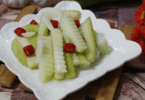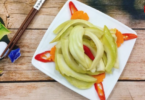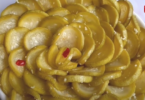Vietnamese Pickled Water Celery (Rau Can Muoi) – A Simple yet Delicious Side Dish
Are you looking for a new condiment to spice up your meals? Try Vietnamese Pickled Water Celery, also known as Rau Can Muoi. This dish is popular in Vietnam for its crisp texture, fresh taste, and tangy flavor. It pairs perfectly with grilled meats, fried dishes, or any food that could use a burst of brightness. In this article, we will show you the ingredients and the process of pickling your own water celery at home. Let’s get started!
What Is Vietnamese Pickled Water Celery?

Vietnamese Pickled Water Celery, or Rau Can Muoi, is a traditional Vietnamese pickled dish loved for its crisp texture and tangy flavor. In Vietnam, this simple combination of water celery, salt, vinegar, and sometimes chili peppers transforms ordinary greens into a refreshing side that perfectly balances heavier meals. Many families enjoy rau can muoi alongside grilled meats, fried foods, or just a bowl of hot rice. Its light, crunchy taste brings a burst of freshness to any meal, making it a cherished part of Vietnamese food.
Ingredients You Need

- 300 grams fresh water celery
- 1 liter water
- 100 milliliters vinegar (white or rice vinegar)
- 1 tablespoon salt
- 2 tablespoons sugar
- 2 cloves garlic
- 1 chili pepper
How to Make Vietnamese Pickled Water Celery
1. Prepare the Water Celery

- Rinse 300 grams of fresh water celery under running water to remove dirt.
- Cut the stems into pieces about 5 cm long.
- Check for any tough outer fibers and peel them off if needed.
- Soak the pieces in a bowl of clean water with a pinch of salt for about 5 minutes.
- Drain and set aside.
2. Create the Brine

- In a small pot, pour 1 liter of water.
- Add 1 tablespoon salt and 2 tablespoons sugar.
- Stir to dissolve.
- Bring the mixture to a gentle boil, then reduce the heat.
Add 100 milliliters of vinegar (white or rice vinegar). - Stir again for a few seconds, then turn off the heat.
- Let the brine cool to room temperature.
3. Pack the Jar

- Place the drained water celery into the clean jar.
- Add 2 cloves of thinly sliced garlic and 1 sliced chili pepper (optional for spice).
- Pour the cooled brine over the vegetables until they are fully submerged.
- Make sure there are no air pockets.
- Seal the jar tightly.
4. Store and Serve

- Once your pickles reach the desired tanginess, store the jar in the fridge.
- They should stay crisp and tasty for up to a week.
- Serve your pickled water celery with rice, grilled meats, or fried dishes.
Pro Tips from My Grandmother
- Choose the Right Stems: My grandmother always insisted on picking the younger, slimmer stems of water celery. She believed they have a more delicate texture and sweeter taste, making them perfect for pickling.
- Add a Splash of Boiling Water: Right before soaking the water celery in the brine, she would pour a small amount of boiling water over the stems. This quick step supposedly kills surface bacteria and also helps them absorb the brine more evenly.
- Layer with Herbs: Sometimes she would add a few sprigs of fresh herbs, like Vietnamese coriander (rau ram) or a couple of basil leaves, to the jar. She said it gave the pickle an extra layer of fragrance and a hint of spice.
- “Never Let Air In!”: She always pressed the celery down so it stayed completely submerged. According to her, exposing the vegetables to air could create unwanted mold and spoil the pickling process.
- Serve with a Smile: Finally, grandma would arrange pickled water celery on a small plate, garnish it with a few fresh chili slices for color, and place it in the center of the table. She believed a beautiful presentation made everyone excited to eat, turning a simple condiment into a special treat.
- Store in a Cool, Dark Place: While we usually keep the pickle jar in the fridge, grandma sometimes placed it in a shaded corner of the kitchen for the first 24 hours. She believed this slower fermentation let the flavors “get to know each other,” resulting in a more harmonious taste.
- Revive a Mildly Flat Pickle: If the celery starts to lose its crispness after several days, grandma’s trick was to add a little fresh vinegar and a pinch of salt. She would gently shake the jar to mix everything, and let it rest for another hour or two. Most of the time, the celery would perk right back up!

Conclusion
By now, you have learned how to make vietnamese pickled water celery (rau can muoi), a bright and crunchy side dish that perfectly complements heavier meals. This simple recipe adds a refreshing twist to any table, reflecting the heart of Vietnamese cuisine through its balance of flavors.
Ready to give this recipe a try? Share your homemade rau can muoi on social media using #VNIFood. Visit our website to explore more traditional Vietnamese food and condiments.
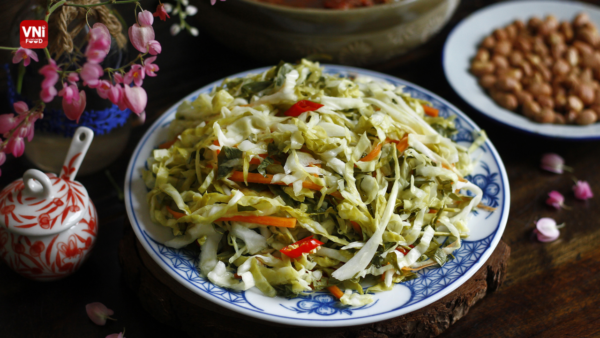
| Prep Time | 15 minutes |
| Servings |
people
|
- 300 g water celery
- 1 liter Water
- 100 ml Vinegar
- 1 tablespoon Salt
- 2 tablespoons Sugar
- 2 cloves garlic
- 1 chili pepper
Ingredients
|

|
- Prepare the Water Celery Rinse 300 grams of fresh water celery under running water to remove dirt. Cut the stems into pieces about 5 cm long. Check for any tough outer fibers and peel them off if needed. Soak the pieces in a bowl of clean water with a pinch of salt for about 5 minutes. Drain and set aside.
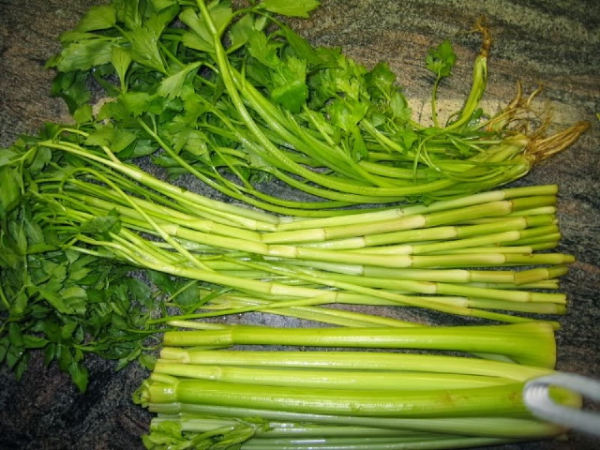
- Create the Brine In a small pot, pour 1 liter of water. Add 1 tablespoon salt and 2 tablespoons sugar. Stir to dissolve. Bring the mixture to a gentle boil, then reduce the heat. Add 100 milliliters of vinegar (white or rice vinegar). Stir again for a few seconds, then turn off the heat. Let the brine cool to room temperature.

- Pack the Jar Place the drained water celery into the clean jar. Add 2 cloves of thinly sliced garlic and 1 sliced chili pepper (optional for spice). Pour the cooled brine over the vegetables until they are fully submerged. Make sure there are no air pockets. Seal the jar tightly.
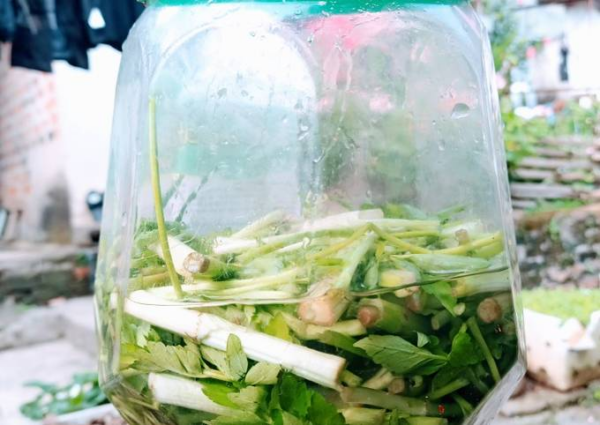
- Store and Serve Once your pickles reach the desired tanginess, store the jar in the fridge. They should stay crisp and tasty for up to a week. Serve your pickled water celery with rice, grilled meats, or fried dishes.



